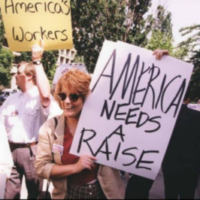Introduction
By any measure, wage theft in America is threatening to become a defining trend of the 21st century labor market. In the past year alone, workers recovered tens of millions of dollars in unpaid wages from their employers in a range of industries. For example, Staples paid $42 million in illegally underpaid wages to its assistant store managers, New Jersey truck delivery drivers received $2 million in an unpaid overtime settlement, Walmart settled an unpaid wages case for $35 million in Washington State, and New York car wash workers received $3.5 million in unpaid overtime.1
Behind these high-profile cases sits a growing body of research that documents a broad and worsening wage theft crisis in America. In a landmark 2009 study, Broken Laws, Unprotected Workers, researchers surveyed more than 4,000 workers in low-wage industries in Chicago, Los Angeles, and New York, and found that 26 percent had been paid less than the minimum wage in the preceding week, and 76 percent had either been underpaid or not paid at all for their overtime hours.2
Dozens of studies by organizers and advocates in specific industries have uncovered similar rates of wage-related violations (as well as related health and safety, workers compensation, and right-to-organize violations).3 And in audits of employers in 1999 and 2000, the US Department of Labor (USDOL) found high rates of minimum wage, overtime and other violations across the country, including in 50 percent of Pittsburgh restaurants, 74 percent of Georgia day care centers, 50 percent of St. Louis nursing homes, 38 percent of Reno hotels and motels, and 47 percent of adult family homes in Seattle, to name just a few.4
Wage theft is not incidental, aberrant or rare, committed by a few rogue employers at the periphery of the labor market. It takes place in industries that span the economy— including retail, restaurants and grocery stores; caregiver industries such as home health care and domestic work; blue collar industries such as manufacturing, construction and wholesalers; building services such as janitorial and security; and personal services such as dry cleaning and laundry, car washes, and beauty and nail salons. Immigrants, women and people of color are particularly hard hit, although all workers are at risk of the many forms of wage theft: being paid less than the minimum wage, working off the clock without pay, getting less than time and a half for overtime hours, having tips stolen, and seeing illegal deductions taken out of paychecks.
Minimum wage and overtime laws are the anchors of the employment relationship in the United States. They are the central vehicle by which public policy guarantees fundamental protections for workers. If we cede these most basic laws to rampant evasion and violation, we are effectively setting the clock back to the early 1900s, before the enactment of the Fair Labor Standards Act (FLSA), when the lack of any wage floor resulted in terrible working conditions.
The wage theft crisis has many roots. Repercussions for violating the law are often not strong enough to dissuade employers, and declining resources and ineffective strategies by government enforcement agencies mean that employers have little fear of getting caught. Inadequate protections for workers who want to make claims of wage theft result in high rates of retaliation. And new forms of work and production, including outsourcing to subcontractors and misclassifying workers as independent contractors, have created confusion and allowed employers to move growing numbers of workers outside the reach of the law.
The case for fighting wage theft is first and foremost about fairness and justice—but it is also about economics. There is the significant cost to workers and their families, which in one week alone is estimated to be $56.4 million in New York, Chicago and Los Angeles combined.5 There is the cost to taxpayers in lost revenues when employers fail to pay payroll taxes. There is the cost to our local economies, with fewer dollars circulating to local businesses, stunting economic recovery. And there is the cost to growth and opportunity as generations of workers are trapped in sub-minimum wage jobs.
Every day, millions of responsible, profitable employers in this country comply with minimum wage and overtime laws. When we allow their unscrupulous competitors to undercut them on labor costs, we are starting a race to the bottom that will reverberate throughout the entire labor market in a cascading loss of good jobs. Everyone has a stake in this issue. Fighting wage theft is not about adding new burdens onto law-abiding employers. It is about smarter enforcement of laws that are already on the books, closing gaping loopholes and enacting stronger enforcement tools.
In this guide, our goal is to support and build upon the surging grassroots energy around wage theft campaigns in cities and states across the country. Advocates are using high-profile street protests and new organizing strategies to target unscrupulous employers. They are mounting multi-year campaigns to update legal protections and set up new enforcement mechanisms. And they are pushing the issue of wage theft onto the airwaves, educating the public and lawmakers alike about the scale of the problem and how to fight it. In the process, they are creating strong, enduring coalitions of worker centers, unions, legal services groups, policy think tanks, and other low-wage worker advocates.
By providing our allies a concrete menu of innovative policies to strengthen enforcement of minimum wage and overtime laws—as well as strategic guidance on identifying which policies make sense in a given community—our hope is that we help turn the tide and shift the American workplace from wage theft to wage justice.
1 Donna Goodman, “Staples to Pay $42M to Settle Wage Claims,” January 30, 2010, http://news.bostonherald.com/business/general/view/20100130staples_to_pay_42m_ to_settle_wage_claims, accessed December 10, 2010; Eric Ortiz, “Raymour & Flanigan Drivers get $2M for OT,” July 8, 2009, http://www.pressofatlanticcity.com/ business/article_394857c2-233c-517c-9dd2-fcf148daac8c.html, accessed December 10, 2010; Gene Johnson “Wal-Mart Settles Lawsuit by Washington Workers for $35M,” July 22, 2009, http://www.usatoday.com/money/industries/retail/2009-07-22-walmart-settlement_N.htm, accessed December 10, 2010; Libby Nelson, “Car Wash Chain to Pay $3.4 Million in Back Wages,” June 30, 2009, http://cityroom.blogs. nytimes.com/2009/06/30/car-wash-chain-will-pay-34-million-in-back-wages/, accessed December 10, 2010.
2 Annette Bernhardt et al., Broken Laws, Unprotected Workers: Violations of Employment and Labor Laws in America’s Cities (New York: Center for Urban Economic Development at UIC, National Employment Law Project and UCLA Institute for Research on Labor and Employment, 2008). The report is available at www.nelp.org/ page/-/brokenlaws/BrokenLawsReport2009.pdf.
3 See for example: Asian American Legal Defense and Education Fund and YKASEC, “Forgotten Workers”: A Study of Low-Wage Korean Immigrant Workers in the Metropolitan New York Area (New York: AALDEF and YKASEC, 2006); Domestic Workers United & DataCenter, Home Is Where The Work Is: Inside New York’s Domestic Work Industry (New York: Domestic Workers United & DataCenter, 2006); Make the Road by Walking and Retail, Wholesale and Department Store Union, Street of Shame: Retail Stores on Knickerbocker Avenue (New York: Department Store Union (RWDSU/UFCW) and Make the Road by Walking, 2005); Restaurant Opportunities Center of New York and New York City Restaurant Industry Coalition, Behind the Kitchen Door: Pervasive Inequality in New York City’s Thriving Restaurant Industry (New York: Restaurant Opportunities Center of New York and New York City Restaurant Industry Coalition, 2005); Abel Valenzuela, et al., On the Corner: Day Labor in the United States (Los Angeles: Center for the Study of Urban Poverty, 2006).
4 US Department of Labor, 1999–2000 Report on Low-Wage Initiatives (Washington, DC: Employment Standards Administration, Wage and Hour Division, 2001).
5 Bernhardt et al., Broken Laws, Unprotected Workers.



